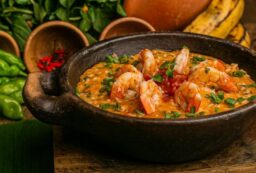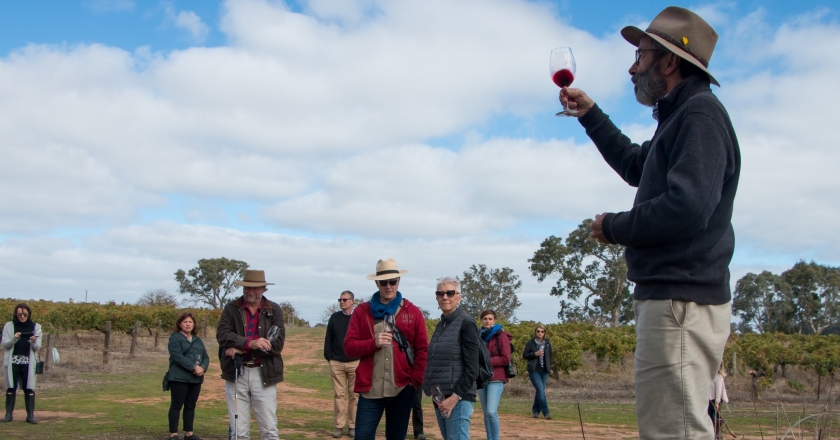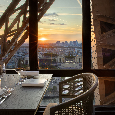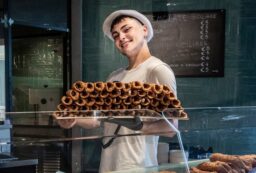
Piemonte, Italy (a.k.a. Piedmont), kisses France along its Alps-defined border. It is famous for its robust Barolo, Barbaresco and Barbera red varietal wines and regional cuisine. These include hearty veal dishes, beef-stuffed agnelotti del plin (the smaller cousin of ravioli), buttery tajarin (an egg-rich angel hair pasta), Bagna cauda (a hot appetizer made with sardines and olive oil), petite gnocchi crafted from root vegetables and, of course, white and black truffles on everything. Depending on who is running the kitchen in city restaurants, village cafes and country wineries, the presentation can either be rustic or glamorous. To truly appreciate what lies at the heart of Piemontese cuisine (or any regional Italian cuisine, for that matter), a visit to a local market is a must.
Fall is usually prime time for some of Italy’s most famous market-styled festivals in Piemonte, such as CioccolaTò taking place in Turin, and the International Alba White Truffle Fair. However, one can get a sense for what “real” people from the area eat any time of year when paying a visit to the market—be it specialty food shop, supermarket or outdoor farmers’ market. In fact, years before professionally organized market visits and tours became a staple activity in every itinerary, anybody serious about regional Italian cooking owed it to themselves to shop like a local, to find distinct regional ingredients, observe correct ways of cooking with them, and gain motivation to recreate certain dishes incorporating them at home.
 Alba-born entrepreneur Oscar Farinetti felt the same way about food shopping. He wondered how it could be rethought as dinner-and-a-show experience that was informal, flexible and did not necessarily involve dinner. This concept, sketched out on a piece of paper in 2002 and took flight as the original Eataly by 2007.
Alba-born entrepreneur Oscar Farinetti felt the same way about food shopping. He wondered how it could be rethought as dinner-and-a-show experience that was informal, flexible and did not necessarily involve dinner. This concept, sketched out on a piece of paper in 2002 and took flight as the original Eataly by 2007.
 The flagship location, in Turin’s Lingotto neighborhood, was built into the former Carpano distillery and happens to be few steps from the Fiat Lingotto Factory (itself repurposed as a mall with its own food court). Although it requires a half-hour commute from the city center on Turin’s subway, it is worth a visit to see Farinetti’s first version of an emporium containing “high-quality, sustainable food” that “celebrates Italian biodiversity, and creates an informal, natural, and simple place to eat, shop, and learn.” The food-as-entertainment complex’s formula has since become an international juggernaut, with more than 35 locations throughout Italy and the world.
The flagship location, in Turin’s Lingotto neighborhood, was built into the former Carpano distillery and happens to be few steps from the Fiat Lingotto Factory (itself repurposed as a mall with its own food court). Although it requires a half-hour commute from the city center on Turin’s subway, it is worth a visit to see Farinetti’s first version of an emporium containing “high-quality, sustainable food” that “celebrates Italian biodiversity, and creates an informal, natural, and simple place to eat, shop, and learn.” The food-as-entertainment complex’s formula has since become an international juggernaut, with more than 35 locations throughout Italy and the world.
 Eataly “v1.0” still does not disappoint after over a decade in business, with its stylized stations showcasing charcuterie, cheese, pasta, artisanal baked goods and a display of achingly photogenic produce running half the length of the first floor. There are painstakingly drawn chalkboards in strategic places, listing upcoming in-store events as well as book displays reminiscent of the old Rizzoli booksellers in New York City. And there are actual Piemonte residents (albeit a well-heeled group akin to Whole Foods shoppers in North America) buying their groceries for the week. While Piemonte’s bounty is emphasized, other regions of Italy are highlighted. With such a visual feast, it is easy to miss the Carpano Museum, dedicated to the birth and evolution of vermouth.
Eataly “v1.0” still does not disappoint after over a decade in business, with its stylized stations showcasing charcuterie, cheese, pasta, artisanal baked goods and a display of achingly photogenic produce running half the length of the first floor. There are painstakingly drawn chalkboards in strategic places, listing upcoming in-store events as well as book displays reminiscent of the old Rizzoli booksellers in New York City. And there are actual Piemonte residents (albeit a well-heeled group akin to Whole Foods shoppers in North America) buying their groceries for the week. While Piemonte’s bounty is emphasized, other regions of Italy are highlighted. With such a visual feast, it is easy to miss the Carpano Museum, dedicated to the birth and evolution of vermouth.
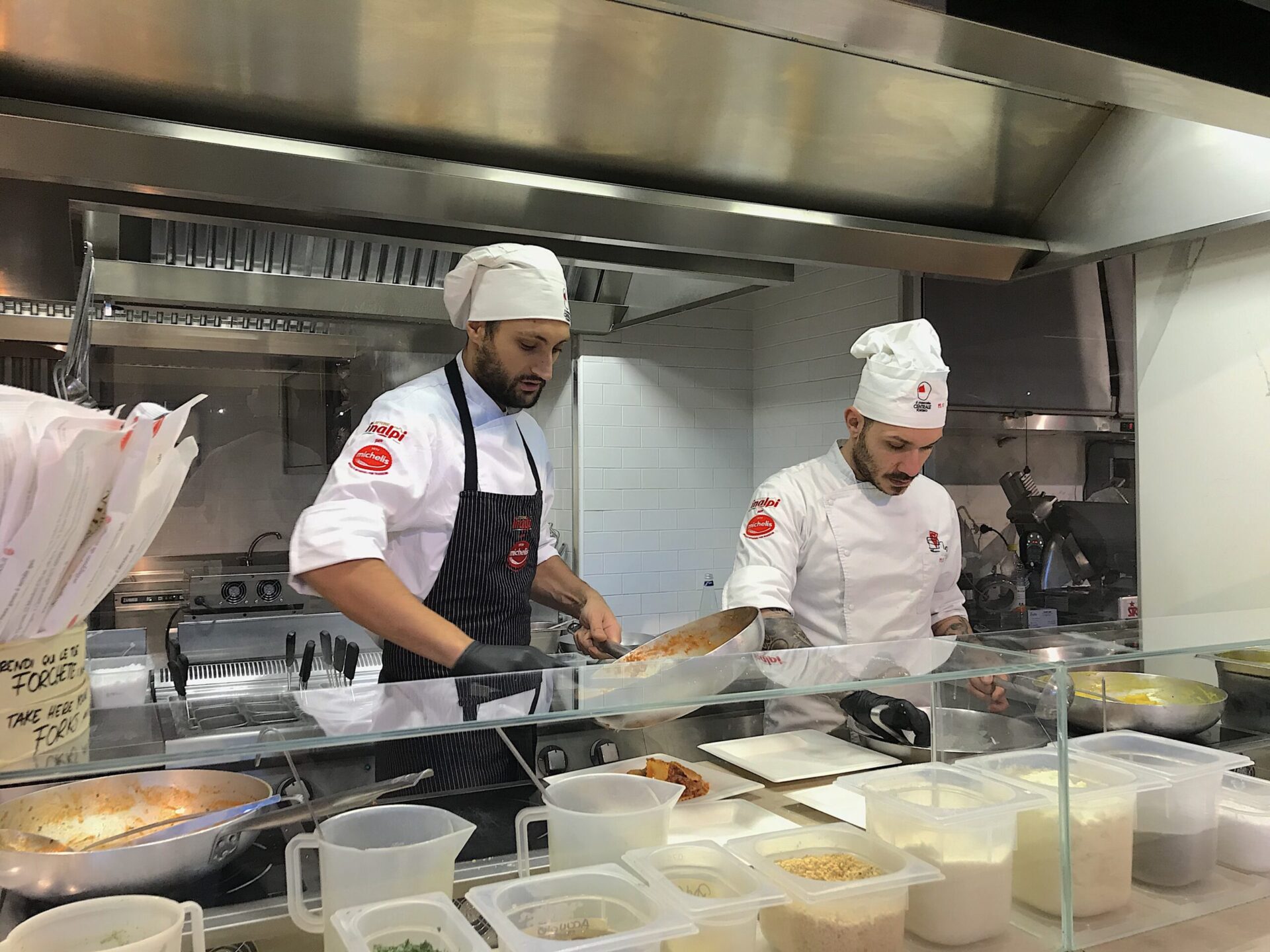
"To truly appreciate what lies at the heart of Piemontese cuisine, a visit to a local market is a must."
First floor restaurants run the gamut from aromatic pizza and pasta stalls with open-concept kitchens to a 1-star Michelin restaurant (Casa Vicina) and Bistrot La Taverna del Re, an offshoot of 1-star Michelin restaurant Guido in Serralunga d’Alba. The former serves a delightful three-course truffle-centric meal when supplies allow. Eataly also has its own behind-the-scenes food tour, meeting and greeting the resident food artisans, as well as bigger tours around Turin. There is also a steady stream of workshops, full-on cooking lessons upstairs and tasting sessions in the impressive basement enoteca (wine shop). There, you will find 5,000 labels from wineries throughout Italy, 50,000 bottles of international wines, and special areas dedicated to Piemonte’s signature wines (Barolo and Barbaresco) and Italian craft beer. Wine bar “Pane e Vino” and a Martini & Rossi-themed cocktail bar complete the lower floor.
 The Mercato Centrale Torino, a few blocks from Torino’s city center at Porta Palazzo, can arguably be described as a more intimate variation of the Eataly formula. On closer inspection (or a visit to the website), one realizes Mercato Centrale is part of a chain, with other locations in Rome and Florence. However, what surrounds the modern glass building—a sprawling, less touristy market with no-frills produce, foodstuffs and dry goods vendors established in 1835—adds that dash of authenticity some food purists crave. Porta Palazzo (“Palace Gate”) effectively was the original front door to the city that over time ushered in immigrants from Southern Italy, and from the 1980s forward, merchants and future residents from the Middle East, Eastern Europe, South America and Asia, putting their cultural and culinary stamps on the city’s character and cuisine.
The Mercato Centrale Torino, a few blocks from Torino’s city center at Porta Palazzo, can arguably be described as a more intimate variation of the Eataly formula. On closer inspection (or a visit to the website), one realizes Mercato Centrale is part of a chain, with other locations in Rome and Florence. However, what surrounds the modern glass building—a sprawling, less touristy market with no-frills produce, foodstuffs and dry goods vendors established in 1835—adds that dash of authenticity some food purists crave. Porta Palazzo (“Palace Gate”) effectively was the original front door to the city that over time ushered in immigrants from Southern Italy, and from the 1980s forward, merchants and future residents from the Middle East, Eastern Europe, South America and Asia, putting their cultural and culinary stamps on the city’s character and cuisine.
 In contrast to Eataly, which has a general checkout section in the front, every shop inside the Mercato is independently operated, sells its own products and has its own cash register. The emphasis on Piemonte-crafted ingredients and finished products is more pronounced. One of the centerpieces of the modern indoor market is a small group of preserved cold storage rooms built in the 18th Century that allowed royalty and market vendors to preserve perishable foods. These early “refrigerators” (which one can tour with an advanced reservation) functioned by adding snow through open drains in the roof to small compartments inside the structure that would turn to ice. The floor is sloped towards the center, allowing the water to drain away from the perishables as the ice melted.
In contrast to Eataly, which has a general checkout section in the front, every shop inside the Mercato is independently operated, sells its own products and has its own cash register. The emphasis on Piemonte-crafted ingredients and finished products is more pronounced. One of the centerpieces of the modern indoor market is a small group of preserved cold storage rooms built in the 18th Century that allowed royalty and market vendors to preserve perishable foods. These early “refrigerators” (which one can tour with an advanced reservation) functioned by adding snow through open drains in the roof to small compartments inside the structure that would turn to ice. The floor is sloped towards the center, allowing the water to drain away from the perishables as the ice melted.
 Among the 26 vendors occupying the first floor, there are casual outposts of top tier Turin restaurants, Farmacia del Cambio and Mare Nostrum. There’s also Alberto Marchetti gelato, Beppino Occelli’s cheese and butter, Trapizzino by Stefano Callegari; Girarrosto, and The Sicilian Specialties. Others are laser-focused on vegetarian fare, fried “street foods,” Tuscan beef, a chicken rotisserie, high-end hamburgers, Piedmontese pastas, breads, pastries, truffles, wine shop and there’s even a flour mill. In addition to the Lorenzo de’ Medici cooking school on the second floor, there are open spaces for live performances, demonstrations and community events.
Among the 26 vendors occupying the first floor, there are casual outposts of top tier Turin restaurants, Farmacia del Cambio and Mare Nostrum. There’s also Alberto Marchetti gelato, Beppino Occelli’s cheese and butter, Trapizzino by Stefano Callegari; Girarrosto, and The Sicilian Specialties. Others are laser-focused on vegetarian fare, fried “street foods,” Tuscan beef, a chicken rotisserie, high-end hamburgers, Piedmontese pastas, breads, pastries, truffles, wine shop and there’s even a flour mill. In addition to the Lorenzo de’ Medici cooking school on the second floor, there are open spaces for live performances, demonstrations and community events.
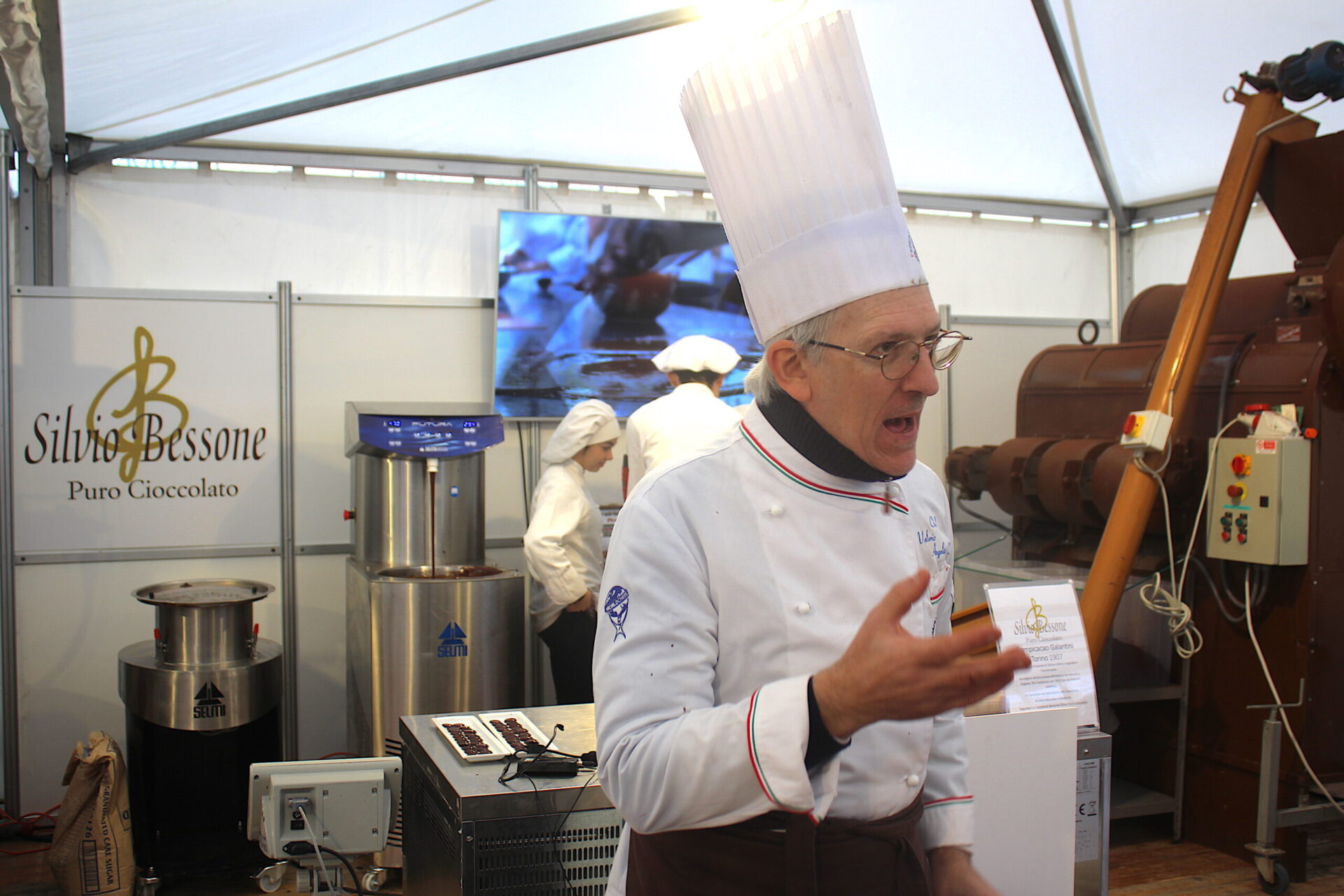 Away from the market crowds, Torino’s large proliferation of time-honored chocolate and gelato shops in the city center stir the senses, not only with handcrafted sweet treat, but also their ornate Art Nouveau, Art Deco and Belle Époque interiors. Kids will be impressed with the fact that Torino is not only the birthplace of Nutella, but also the ice cream bar (a.k.a, “The Pinguino,” invented at Gelati Pepino Turin in 1939), “bicerin” (the most indulgent hot chocolate drink dating back to the 18th Century), and original covered “Gallerias” shopping areas lined with fashion retailers as well as more gelato and chocolate shops.
Away from the market crowds, Torino’s large proliferation of time-honored chocolate and gelato shops in the city center stir the senses, not only with handcrafted sweet treat, but also their ornate Art Nouveau, Art Deco and Belle Époque interiors. Kids will be impressed with the fact that Torino is not only the birthplace of Nutella, but also the ice cream bar (a.k.a, “The Pinguino,” invented at Gelati Pepino Turin in 1939), “bicerin” (the most indulgent hot chocolate drink dating back to the 18th Century), and original covered “Gallerias” shopping areas lined with fashion retailers as well as more gelato and chocolate shops.

"The emphasis on Piemonte-crafted ingredients and finished products is more pronounced."
While Alba, often regarded as the other great food destination of Piemonte, draws thousands of visitors with the aforementioned White Truffle Festival, every weekend throughout the year is a gastronomic celebration with its food markets, including the Mercato Della Terra and the covered market at Piazza Marconi. One can get his or her truffle fix at Tartufi Morra, founded by Giacomo Morra (patriarch of the Alba truffle industry) in 1930. Casale Monferrato, which rolls out like a smaller Alba, is filled with achingly photogenic bakeries. However, the best souvenir spot is Krumiri Rossi Portinaro, a 140 year-old bakery that since 1973 has specialized exclusively in its signature butter cookie. This is done under the direction of Anna Maria Portinaro, whose father took over the brand, bakery and coffee shop in the 1950s. The Enoteca Regionale del Monferrato, built into inside the town’s namesake castle, offers wine flights, books and bottles for sale in a chic, arty setting.
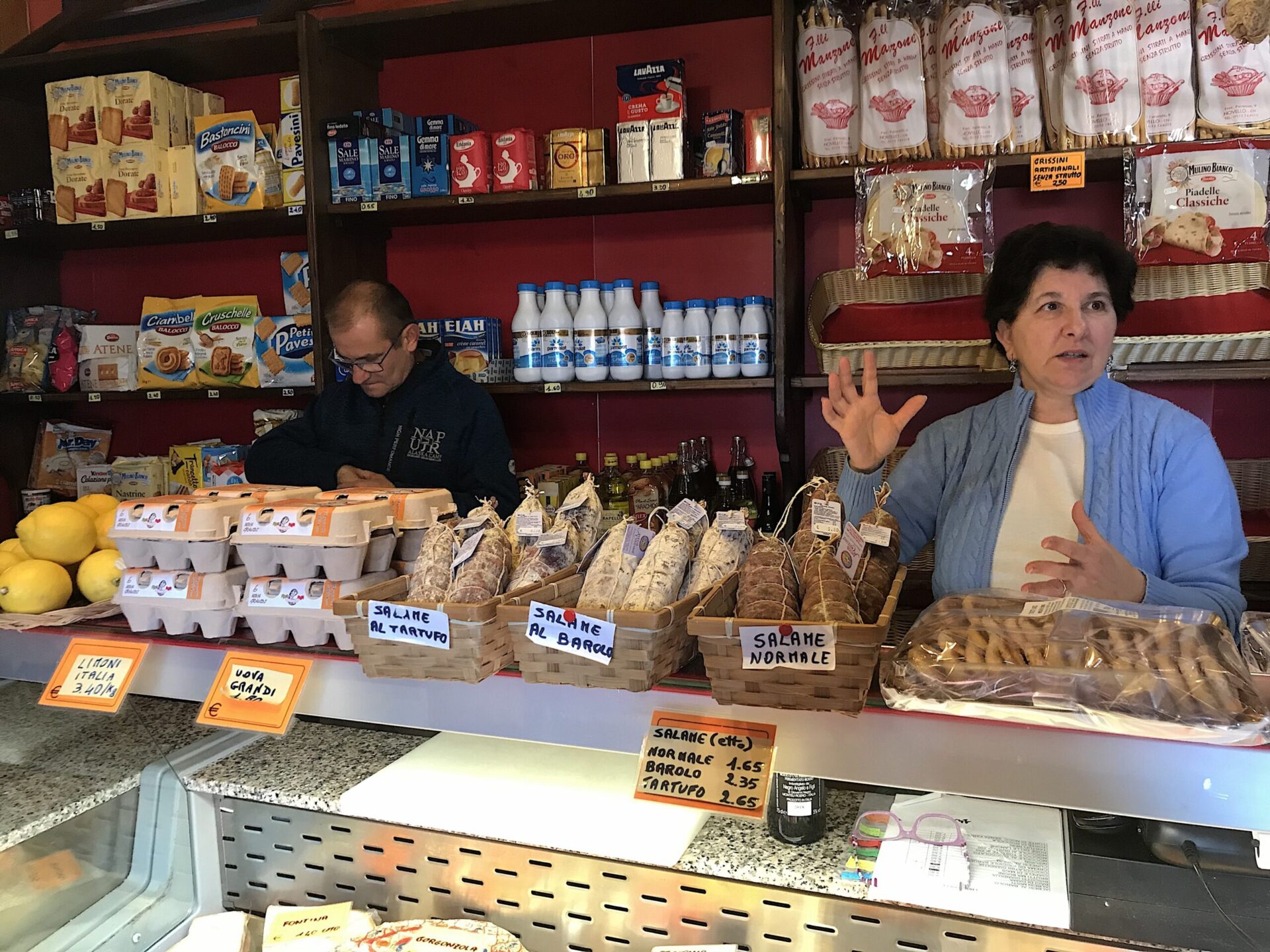 And what to do with all of those fantastic raw materials you bought at those markets? A stay or a series of cooking classes and local market treks at the Albergo dell’Agenzia in Polenzo will ensure anything you’re not allowed to take home will be put to good use. This friendly, understated foodie paradise, built into a former farm (check), adjoins the headquarters of the international “Slow Food” movement, along with its learning institutions, the University of Gastronomic Science and the Banca del Vino.
And what to do with all of those fantastic raw materials you bought at those markets? A stay or a series of cooking classes and local market treks at the Albergo dell’Agenzia in Polenzo will ensure anything you’re not allowed to take home will be put to good use. This friendly, understated foodie paradise, built into a former farm (check), adjoins the headquarters of the international “Slow Food” movement, along with its learning institutions, the University of Gastronomic Science and the Banca del Vino.

Cooking, wine tasting and food-related activities are offered on the neo-Gothic campus, transformed in the 1830s by nobleman, Carlo Alberto of Savoy. The concierge service is prepared to book guests on biking and hiking tours around the region. At breakfast, the items on the buffet are not just heavenly, but painstakingly labeled in accordance with Slow Food’s guidelines, with names of producers, provenance and nutritional benefits.






